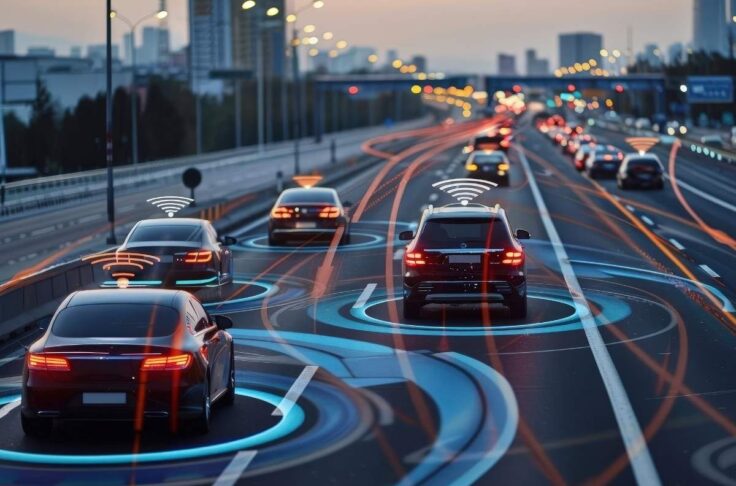Prioritizing High-Value Space: The Curbside
Summary
Rethinking how cities, businesses, and people use the curbside has the potential to change urban mobility. Examples show how prioritizing high-value space changes cityscapes, makes them more livable and gives shared services the chance to truly change how people get around.

In a traditional image of a city, you can expect to see two key components near a curbside: a parked car on the road, and beside it, a much smaller space for pedestrians. This layout is replicated across cities large and small, even though it is not efficient for anyone, regardless if they choose to drive or walk. Add in today’s evolving mobility options, and it becomes more obvious that the curbside can be used in much better ways.
Supporters of the status quo would argue that the curb belongs to the on-street businesses and more of it is needed for more business; metered parking is a large revenue stream for cities, and that street parking is key to getting people to spend money around the city. These arguments have been ingrained in the planning of many cities, and at the surface makes sense. However, these preconceived notions do not stand up against the untapped opportunities of the curbside.
According to Josh Johnson, Advanced Mobility Manager at the City of Minneapolis:
“Continued innovation in transportation, as well as an increase in competition for curb space, has greatly increased the need to understand, evaluate, and right-size use and pricing of the curb. With the dramatic growth in shared mobility options and delivery services, there is a significant need to address how and where they access curb space. Additionally, thinking needs to shift from prioritizing cars to understanding how people want to move and use the mobility options available to them, and reallocate space accordingly.”
As shared mobility services become more prominent in cities of all shapes and sizes, the fight for curbside space contributes heavily to the success of these new transportation services. Station-based carsharing would not be feasible if cities did not allocate or offer on-street parking. Ride-hailing services could not function if they did not have access to the curb. Ride-pooling would be even more difficult to operate if pick-ups could not be done at the corner of any block. Kick scooter sharing would not be possible if they were banned from parking on sidewalks.
While successful carsharing, scooter sharing, or any type of shared mobility service could potentially negotiate themselves an ideal parking arrangement, it is up to the city to enforce guidelines that embrace forms of mobility other than just the private car. At the same time, more people need to understand the benefit of more complete streets and support the curb’s redevelopment into a space that is valuable to everyone.

Common Obstacles to Overcome
Automobile dependency – This is the concept that in city planning, cars are prioritized over other forms of mobility, such as walking, biking, or even public transit. This isn’t surprising, as private vehicles have been the main form of day-to-day transportation since horse-drawn carriages. However, this has resulted in cities that address congestion with more roads, which only cause more traffic. In addition, many city infrastructures better support the movement of people who are in cars, but not transit riders or pedestrians.
Urban intensification – The ideal scenario of building a community where people can live, work, and shop within walking distance paints a picture of minimal car usage. However, if you compare the downtown core and the suburban areas of a city like Toronto, you will see that vehicle reliance is similar, resulting in congestion even in the dense neighbourhoods. Research from Wharton found that every 10% increase in density leads to a 1% decrease in travelling, which they note as an insignificant amount. Even though density is part of the solution to making multi-modal trips more feasible, it needs to work alongside other initiatives as well.
Brick and mortar businesses – Businesses with storefronts tend to incorrectly believe most of their patrons come from the private vehicle, and rely on the spots in front of their store. However, the National Association of Transportation Officials (NACTO) found that in Los Angeles, merchants thought 36% of their patrons arrived by car and none by transit. In reality, 46% arrived by transit and only 7% by car. The same scenario held true in Brooklyn and San Francisco as well.

Who Did it Well, and How
Car-free zones in Ljubljana – In 2006, Ljubljana’s mayor set out to improve the quality of life in the city, and that started with removing cars on the road. By making the city’s core car-free and only allowing permit-holding vehicles to make deliveries from 6 am to 10 am, people now have more space to socialize, enjoy the riverside, and dine on the endless patios – all in unpolluted peace. For those who do need mobility assistance, there is Kavalir, a free electric taxi service that serves the car-free zone. There is also a local bikeshare program, which is easy to use because the same card is used to take transit or rent out a library book. While the decision to go car-free wasn’t always supported by locals, Ljubljana can now proudly call themselves the European Green Capital.
Complete streets in Chicago – In cities like Chicago, there are rush hour lanes that are cleared of parked cars during peak periods, with the intention of allowing more cars to flow through the city. For transit riders, however, this has minimal benefit, as busses end up slowing traffic with frequent stops, and drivers become impatient. Instead, these rush hour lanes should be converted into dedicated bus lanes. On Madison Street in Chicago, 55% travel along the street as pedestrians, 21% by bus, and only 16% by cars. Yet most of the space is dedicated to cars. Even when dedicated bus lanes were implemented, car and bus conflict still remained, with cars still using the space for their own needs. However, once the bus lanes were painted red, the number of stopping violations decreased by 52% and bus conflicts decreased by 67%. These efforts are needed as a step towards complete streets that have more space for pedestrians, cyclists, and transit users.
Curbside patios in Vancouver – Public spaces bring people outside to enjoy the city they live in, and that is something Vancouver has leveraged, while removing parked cars on the road. In 2017, the city launched a pilot project to convert curbside parking space into patios and parklets, with the intention of more effectively using public space. Follow-up studies found that these spaces created a sense of community, added unique designs to city streets, and offered a place for socializing. 64.4% of businesses said the parklets have improved the neighbourhood. By putting these parklets on the road as opposed to the sidewalk, more space is opened up for foot traffic, giving pedestrians more space to enjoy the city outside of their car.

Moving Forward in Shared Mobility
Even without shared mobility, the push for better use of the curb space, on both the road and sidewalk, is key to making cities more liveable. The phrase “build it and they will come” holds true for city infrastructure, even if the decision to remove space for cars is unpopular at first. Now that cities are growing in population, cars are clogging up the road, and people are discovering new ways of getting around with shared mobility, cities are facing a critical need to redesign their streets.
Making this type of change isn’t easy, and it is important to look at data on how curb space is used, and what changes are needed. Josh Johnson from the City of Minneapolis says
“It all starts with inventorying and digitizing curb space to ensure there is an understanding of what is out there. Minneapolis is currently in this process, and should be done with all priority areas (with the exception of residential streets) by end of the summer. From there it takes a combination of data collected from mobility service providers and other users of curb space to establish a basic understanding of need, and start to work towards reallocation.”
Initiating change starts with having the right information, and from there, pilots help understand people’s behaviour in how they use the new space or infrastructure. According to Johnson, “Curbside and land use combined can contribute significantly to the desirability of a city and its neighborhoods. By improving walkability, bike infrastructure, mobility options and connections to transit, we can attract more people, economic development, and continued support of the city’s livability goals.”
City space needs to be built for the people, by the people. The standard notion that on-street parking is necessary or that sidewalks only need to be built to the minimum required width does not benefit the growth of a city. By re-evaluating the value and potential of the curbside, cities can take people outside the comforts of their car to build a stronger community within their city.


